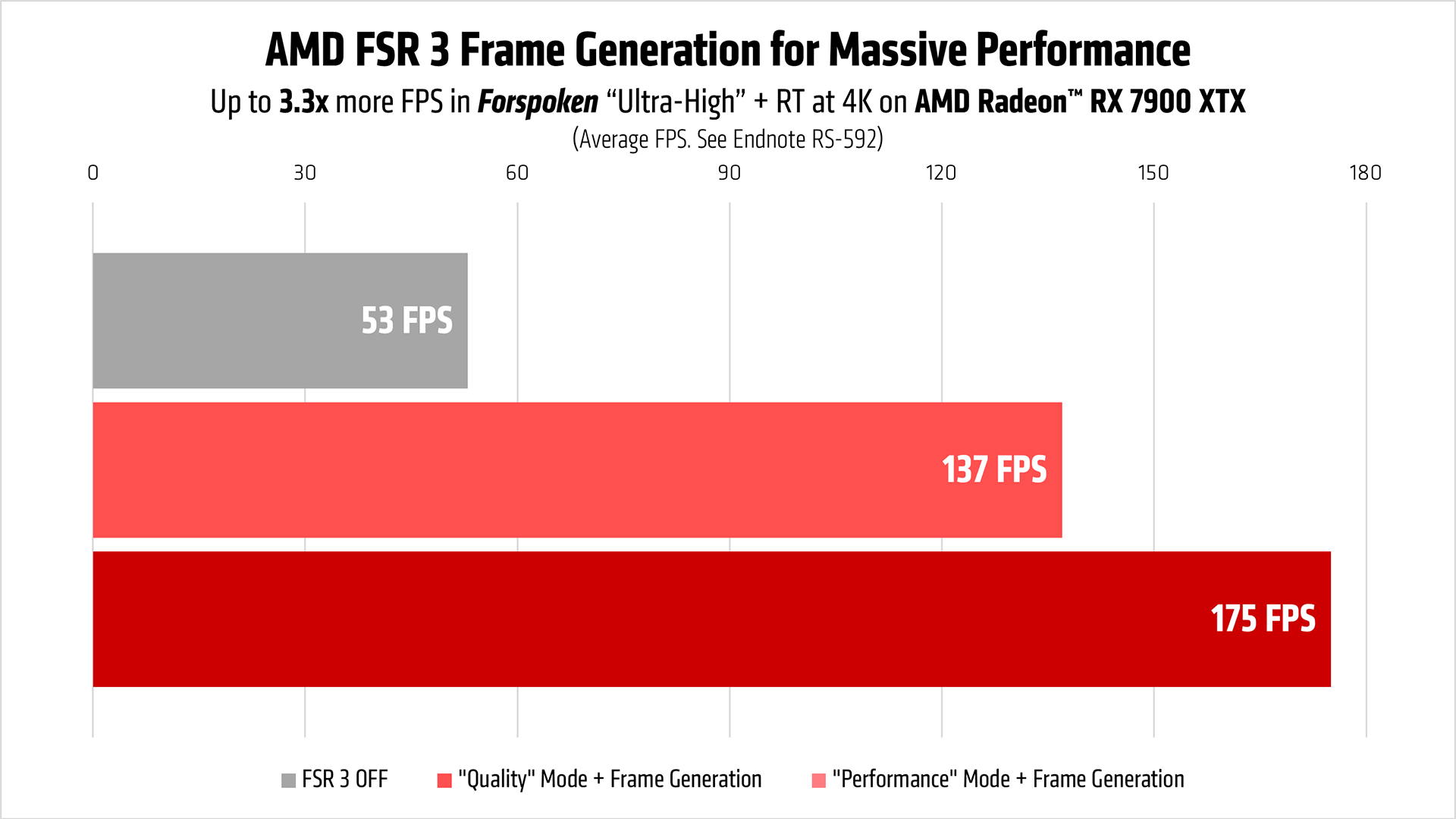AMD Radeon RX 7700 XT & 7800 XT debut alongside new FSR 3.0 tech to rival DLSS 3
AMD's new GPUs are cheaper than a GeForce RTX 4070

AMD revealed two new graphics cards alongside some new upscaling tech during Germany's Gamescom event this weekend (August 25), and these new GPUs are priced to compete with Nvidia's GeForce RTX 4000 cards.
That's a big deal because the new Radeon RX 7700 XT and 7800 XT cards fill out the middle tier in the AMD Radeon RX 7000 series lineup, which has until now been limited to the low-end RX 7600 ($269) and the high-end RX 7900 XT/RX 7900 XTX ($899/$999) cards.
The new cards AMD unveiled this weekend land squarely in the middle of that price range, with the RX 7700 XT retailing for $449 and the beefier RX 7800 XT priced at $499. They'll start showing up on store shelves in September.
AMD also showed off a new version of its FidelityFX Super Resolution upscaling tech alongside these new cards. Called FSR 3, it improves on the old FSR 2 tech in a few key ways that bring it closer to competing with Nvidia's DLS33 upscaling and graphical smoothing tech.
And unlike DLSS, AMD's FSR tech runs just fine (in supported games) on most competing GPUs from Intel and Nvidia, so it's something you may end up benefitting from even if you don't own an AMD graphics card. There are also some minor new features coming to AMD cards which are only available on the current 7000 series that I'll explain shortly, but first — specs!
AMD Radeon RX 7700 XT & 7800 XT: Specs
| Row 0 - Cell 0 | Radeon RX 7700 XT | Radeon RX 7800 XT | Radeon RX 7900 XT |
| Price | $449 | $499 | $899 |
| Compute units | 54 | 60 | 84 |
| Ray accelerators | 54 | 60 | 84 |
| Infinity Cache | 48 | 64MB | 80MB |
| Max memory size | 12GB GDDR6 | 16GB GDDR6 | 20GB GDDR6 |
AMD Radeon RX 7700 XT & 7800 XT: Price and availability
These new cards fill in the middle range between the high and low end of AMD's Radeon RX 7000 series, and they're priced to compete with Nvidia's GeForce RTX 4060 Ti ($399) and 4070 ($599) cards.
The AMD Radeon RX 7700 XT will cost $449 while the RX 7800 XT will cost $499, and you should expect to see versions of both in graphics cards from third-party vendors like Asus, Biostar, Gigabyte and Sapphire hitting store shelves September 6. AMD will also sell its own version of the more powerful RX 7800XT via its website on September 6.
Sign up to get the BEST of Tom's Guide direct to your inbox.
Get instant access to breaking news, the hottest reviews, great deals and helpful tips.
Those prices are actually a bit cheaper than what AMD was charging for similar cards from the prior generation. The RX6800 XT debuted in 2020 for $649, for example, while the less powerful RX6700 XT came a year later at a more reasonable $479.
AMD claims these new cards are optimized for high-quality gaming at 1440p, and if they can outperform Nvidia equivalents like the 4060 Ti and 4070 at 1440p they'll be compelling alternatives for folks building (or upgrading) gaming PCs in 2023.
AMD Radeon RX 7700 XT & 7800 XT: New features
These new AMD GPUs support a slew of new features which make them more performant than prior generations, including upgraded ray accelerators (for more effective raytracing), upgraded dual media engines (for better video encoding/decoding) and a new AMD Radiance Display engine that can help power up to a 480Hz refresh rate on a 4K display.
But there's also a very special upgrade that AMD unveiled alongside the new Radeon RX 7700 XT and 7800 XT cards: FSR 3.0.

This is the latest version of AMD's FidelityFX Super Resolution, the company's open-source tech for making games look better. The most notable way FSR accomplishes this is by generating a lower-resolution version of an image that's about to be sent to your display and intelligently blowing it up to a higher resolution like 1440p or 4K, using algorithms to fill in the details in a way that's meant to make the image appear faster without looking any worse.
That's what was already happening with FSR 2.0, and it's very similar to what competitor Nvidia's cards can do via its proprietary DLSS (Deep Learning Super Sampling) tech. What's different is that Nvidia's tech relies on machine learning and can only be used with Nvidia's GPUs, whereas AMD's FSR tech runs on graphics cards from AMD, Intel and Nvidia.
That means that even though FSR 3.0 is being unveiled alongside the new RX 7700 XT and 7800 XT cards it will run on any RX 7000-series card from AMD, as well as any 40-series card from Nvidia and even some older models.
The big new feature coming in FSR 3.0 is frame generation, which Nvidia added to DLSS 3 at the tail end of 2022. It's basically a way of boosting framerates even higher in games that support it by generating new frames between existing frames. Nvidia's tech uses machine learning to do this, while AMD's new FSR 3.0 frame generation tech uses game motion vector data and AMD Fluid Motion Frames technology.
We won't know for sure how well this works until we see it in action, but the idea is that these new GPUs are powerful enough to intelligently generate "new" frames (that is, images that aren't coming from the game itself) and insert them into live gameplay, making the game appear to move faster and smoother.
While FSR 3.0 and its new frame-generation capabilities are the most exciting bit of news around these new cards, you don't need the latest AMD card to take advantage of it. Thanks to AMD's open-source mindset, this tech should work on any modern AMD or Nvidia GPU once games start gaining FSR 3.0 support later in 2023.
There is one feature coming that's only accessible on the current lineup of AMD Radeon RX 7000 series cards, and it's got some incredible branding. The AMD Software: Adrenalin Edition app, which you can use to control your AMD card, is gaining support for the new AMD HPRX-RX and Radeon Anti-Lag+ features. The new Anti-Lag+ feature builds on the existing AMD Radeon Anti-Lag tech by letting you customize input lag settings on a per-game basis, while the new AMD HYPR-RX feature gives you new options to control AMD Radeon Super Resolution, AMD Radeon Anti-Lag and AMD Radeon Boost technologies in one interface.
Neither of these new features is as potentially exciting as the performance improvements we may see from FSR 3.0, which is expected to start showing up in games like Cyberpunk 2077 and Forspoken later in 2023.
AMD Radeon RX 7700 XT & 7800 XT: Outlook
These new AMD cards help fill out the mid-range of AMD's 7000 series graphics card lineup, giving us a good sense of where the graphics card market is at as we head into the 2023 shopping season.
And while true chipheads will be able to spend weeks debating the finer points of each card and their price/performance ratio, we can step back and see at a glance that AMD is clearly outcompeting Nvidia in terms of price. The fact that both of these new mid-range AMD cards cost less than $500 means they're both less expensive than their predecessors and cheaper than competing cards from Nvidia.
I'm not qualified to declare the great GPU crisis truly over, but it sure seems like those of us who remember new graphics cards regularly costing over $1k at launch can breath a sigh of relief. With AMD about to drop a slew of mid-range cards into the market and new Intel Arc GPUs rumored to debut this fall, the days of paying overinflated prices for new graphics cards may finally be over.

Alex Wawro is a lifelong tech and games enthusiast with more than a decade of experience covering both for outlets like Game Developer, Black Hat, and PC World magazine. A lifelong PC builder, he currently serves as a senior editor at Tom's Guide covering all things computing, from laptops and desktops to keyboards and mice.











